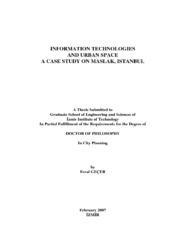Please use this identifier to cite or link to this item:
https://hdl.handle.net/11147/2982Full metadata record
| DC Field | Value | Language |
|---|---|---|
| dc.contributor.advisor | Avar, Adile | - |
| dc.contributor.author | Geçer, Feral | - |
| dc.date.accessioned | 2014-07-22T13:48:41Z | - |
| dc.date.available | 2014-07-22T13:48:41Z | - |
| dc.date.issued | 2007 | - |
| dc.identifier.uri | http://hdl.handle.net/11147/2982 | - |
| dc.description | Thesis (Doctoral)--Izmir Institute of Technology, City and Regional Planning, Izmir, 2007 | en_US |
| dc.description | Includes bibliographical references (leaves: 159-186) | en_US |
| dc.description | Text in English; Abstract: Turkish and English | en_US |
| dc.description | xiii, 197 leaves | en_US |
| dc.description.abstract | The subject of the thesis is to examine the urban transformations that have taken place recently in Istanbul due to the dominant use of information technologies (IT)under the globalization process. Technological developments especially in the Information Technology (IT) and the telecommunications sector, influence cities and urban spaces in social, cultural and physical terms. The study focuses on the impact of IT on urban space transformations and processes in Maslak which has emerged as the new central business district for highly intensive IT user firms via a chronologically based data series.Recently Istanbul is a subject to a new kind of transformation in social,economical and physical structures. There is a new economical system enlarging upon the whole world. The globalized cities, as the capitals of this new economy, form new hinterlands which may not be geographically connected instead, associated via virtual linkages of fiberoptics and satellites of information systems and technologies. As a city strongly influenced by the globalization process which is undeniably armed by IT, Istanbul sticks out in Turkey in the world cities inventory.The problem of the thesis is constituted along the debates between two urban form theories: deconcentration theory and economic restructuring theory. This research examines two fundamental questions. First, which functions that used to be in the city are dispersed from the center and why? Second, which functions prefer urban space and tend to be together creating new kinds of agglomerations in some new places such as Maslak? Indeed, through the findings of the study, it is evidently observed with the presented data that, in the transformation process of Istanbul CBD, there are various factors accompanying the alterations in the urban space other than IT. IT is added to this process as a sidelong factor. | en_US |
| dc.language.iso | en | en_US |
| dc.publisher | Izmir Institute of Technology | en_US |
| dc.rights | info:eu-repo/semantics/openAccess | en_US |
| dc.subject.lcc | HT178.T82 G29 2007 | en |
| dc.subject.lcsh | Urban renewal--Turkey--Istanbul | en |
| dc.subject.lcsh | Information technology | en |
| dc.subject.lcsh | Public spaces | en |
| dc.title | Information Technologies and Urban Sapce Acase Study on Maslak, İstanbul | en_US |
| dc.type | Doctoral Thesis | en_US |
| dc.institutionauthor | Geçer, Feral | - |
| dc.department | Thesis (Doctoral)--İzmir Institute of Technology, City and Regional Planning | en_US |
| dc.relation.publicationcategory | Tez | en_US |
| dc.identifier.wosquality | N/A | - |
| dc.identifier.scopusquality | N/A | - |
| item.grantfulltext | open | - |
| item.openairecristype | http://purl.org/coar/resource_type/c_18cf | - |
| item.openairetype | Doctoral Thesis | - |
| item.languageiso639-1 | en | - |
| item.cerifentitytype | Publications | - |
| item.fulltext | With Fulltext | - |
| crisitem.author.dept | 02.03. Department of City and Regional Planning | - |
| Appears in Collections: | Phd Degree / Doktora | |
Files in This Item:
| File | Description | Size | Format | |
|---|---|---|---|---|
| T000634.pdf | DoctoralThesis | 228.72 MB | Adobe PDF |  View/Open |
CORE Recommender
Page view(s)
268
checked on Apr 28, 2025
Download(s)
96
checked on Apr 28, 2025
Google ScholarTM
Check
Items in GCRIS Repository are protected by copyright, with all rights reserved, unless otherwise indicated.